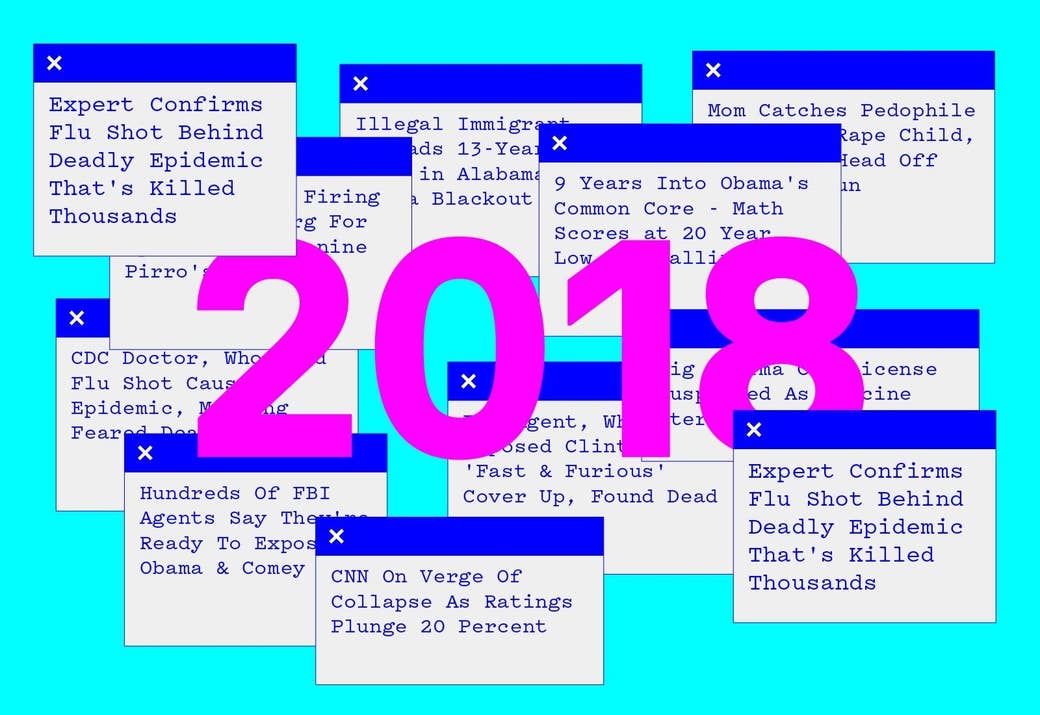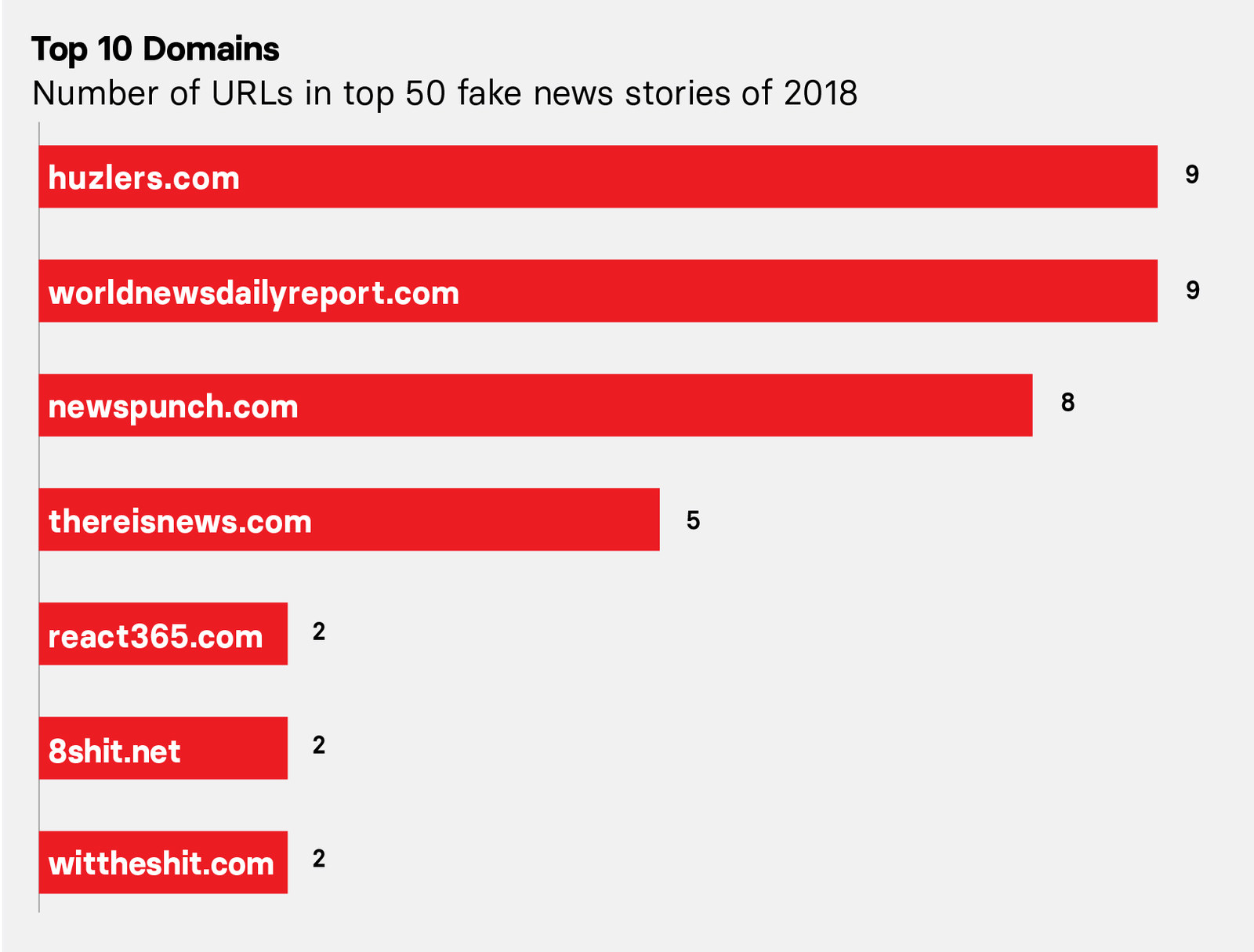
After spending two years launching third-party fact-checking programs, rolling out News Feed updates, and investing in other anti-misinformation initiatives, Facebook is still the home of viral fake news.
For the third year in a row, BuzzFeed News compiled a list of 50 of the most viral false stories on Facebook and measured their total engagement on the platform. And in spite of a prediction from Facebook’s top anti-misinformation product manager that these articles would see a decline in engagement in 2018, this year’s top-performing hoaxes generated almost as many shares, reactions, and comments as last year’s.
The top 50 fake stories of 2018 identified by BuzzFeed News generated roughly 22 million total shares, reactions, and comments on Facebook between Jan. 1 and Dec. 9, 2018, according to data from BuzzSumo and Trendolizer. This was only 7% fewer engagements than the 23.5 million engagements generated by to top 50 of 2017, and slightly more than the top 50 fakes identified by BuzzFeed News in 2016, when those links generated 21.5 million engagements.

Tessa Lyons, a Facebook product manager who oversees its anti-misinformation effort, predicted in an interview last year with BuzzFeed News that the 2018 numbers would show a clear decline as a result of new product efforts.
“When I look over the list, honestly, I feel like the things we launched in the last quarter [of 2017] in particular are going to address at the viral hoaxes you identified,” she said at the time. “I’m certain that the list next year will be smaller [in terms of engagement], but the tactics being used will be different.”
The engagement numbers declined only marginally, but new tactics did emerge. One trend in the 2018 was that bad actors would launch a site with one or more fake stories and then quickly shift to a new domain name once the story had been flagged by fact-checkers and/or blacklisted by Facebook or other platforms. This tactic is called domain hopping or domain cycling and BuzzFeed News reported on it in March of this year.
Reached for comment this year, Lyons cited recent academic research that found the overall volume of false news is being reduced on Facebook, and also said recent product updates would continue apply pressure on publishers of false news.
“We know this is a highly adversarial issue and takes a multi-pronged approach.”
“We've been working hard to stop the spread of false news on Facebook, and we're encouraged by the results. Three recent separate pieces of research — among others — suggest our measures are working and that the overall volume of false news on Facebook is trending downward,” she said in an emailed statement. “We've also recently fixed some enforcement gaps: we've updated our third-party fact-checking ratings to delineate between obvious satire and simply false content, and deployed defenses against the practice of domain cycling, so actors that had previously been trying to seed false news using these methods should see their distribution greatly reduced over the coming months. Still, we know this is a highly adversarial issue and takes a multi-pronged approach.”
Maarten Schenk, editor of the fact-checking site Lead Stories and the developer of Trendolizer, a tool that can be used to track the virality of fake news, told BuzzFeed News it’s become harder for people to make a living pushing fake news on Facebook. But he also cited the prevalence of domain cycling as one challenge Facebook had not yet solved.
“Running a fake news site seems to have become much more difficult this year, with the average lifespan of a new site now being measured in weeks instead of months or years,” he said. “Operators are being forced to move to new domain names as filters and bans kick in faster and faster. On the other hand, website domain names are now so cheap it is almost economical to use a new one for each story."
Six of the top 50 articles on the list were published on briefly used domains that masqueraded as legitimate news outlets, including breaking-cnn.com. That site published a death hoax about Barbara Bush the day before she actually died, and ended up generating more than 2 million likes, shares, and reactions, with the majority of that engagement coming while she was still alive, according Trendolizer data. Other examples inlcude the domains abcnews-us.com and nbc9news.com.
Part of Facebook’s response to domain cycling is to completely block the domain once it’s been identified by third-party fact-checkers. That means people can no longer share links to these domains, which helps reduce the spread of falsehoods. But it also means that Facebook removes the engagement data associated with the domain from publicly accessible sources such as BuzzSumo. This makes it more difficult for journalists and researchers to track how successful these stories were.
That’s why this year BuzzFeed News worked with Schenk and data from Trendolizer to gather stats for stories in cases where Facebook removed data from publicly accessible platforms. Data from Trendolizer was used for two stories in the top 50 list, while the rest of the engagement data came from BuzzSumo. (View the data here, and read about our methodology, and how we incorporated data form Trendolizer, in more detail at the bottom of this post.)
Facebook did not comment on the removal of data related to domains it blocks.
Top Publishers
This year’s top 50 list included many hits from publishers who also appeared in the 2017 edition. World News Daily Report has nine stories on this year’s list, including “Lottery winner arrested for dumping $200,000 of manure on ex-boss’ lawn.” That hoax generated more than 2.3 million Facebook engagements, according to data from BuzzSumo.

The site typically publishes completely false stories about crazy crimes and medical mishaps. It received more than 1.3 million engagements, and third place on this year’s list, for the story, “Woman sues Samsung for $1.8M after cell phone gets stuck inside her vagina.” The site carries a disclaimer that says it “assumes all responsibility for the satirical nature of its articles and for the fictional nature of their content.”
Another top hoax form this year came from a site run by Christopher Blair, a self-described liberal troll who pumps out fake stories targeted at American conservatives. He cycled through several domain names this year to avoid blacklisting by Facebook. His story “BREAKING: Michael Jordan Resigns From The Board At Nike-Takes 'Air Jordans' With Him” falsely reported that Jordan was protesting Nike’s association with Colin Kaepernick. It generated more than 911,000 engagements, according to BuzzSumo, which earned it fourth place on the list.
Blair’s sites also carry a satire disclaimer, and the statement, “If you disagree with the definition of satire or have decided it is synonymous with ‘comedy,’ you should really just move along.” This is in response to criticism that his articles aren’t actually satirical and instead serve to deepen polarization and spread misinformation.
A profile of Blair published by the Washington Post this year showed how his false stories are believed by some Americans, and how Blair and his followers then shower these people with invective and mockery on Facebook.
A Facebook spokesperson said that the platform’s fact-checking partners are now able to rate content from sites with a satire disclaimer as false. This causes the link in question to receive reduced distribution in the News Feed. Previously, fact-checkers had to rate content labeled satire as “Not Eligible,” which created a loophole for sites like World News Daily Report, and those run by Blair.
Schenk says a satire disclaimer had become something of a get-out-of-jail-free card for publishers of false news articles.
“Sites with satire disclaimers are still going strong even though some of the biggest ones aren't really publishing satire,” he said, noting that they trade in “tales involving weird crimes, bizarre sex acts, or revenge fantasies packaged as news.”
“Sites with satire disclaimers are still going strong even though some of the biggest ones aren't really publishing satire.”
These publishers also often see their fake stories plagiarized by other sites, thus increasing the reach. Facebook responded to this by rolling out a new feature that it says can identify multiple versions of the same false story, thereby automatically reducing the distribution of any copycat hoaxes.
Other publishers making a repeat performance on this year’s list are Huzlers.com, a longtime source of fake stories that also carries a satire disclaimer, and YourNewsWire, a site that peddles conspiracy theories and often inserts completely false information into otherwise accurate stories. After being repeatedly flagged by fact-checkers working with Facebook, YNW eventually discarded the yournewswire.com domain and now publishes at newspunch.com.
“I've heard talk from fact-checkers in FB's program that YourNewsWire is now terrified of being fact-checked and immediately retracts or changes headlines when called out by them,” Schenk said.
Overall, he said, while Facebook remains the best place to get a fake story to go viral, the company's anti-misinformation efforts are causing publishers to look to other platforms to spread their content.
“It seems it has become much harder to seed fake news websites via Facebook groups and pages,” he aid. “We are seeing more seeding via Twitter, Gab, or Reddit.”
Methodology
Over the past four years, BuzzFeed News has maintained lists of sites that publish completely fabricated stories. As we encounter new ones and debunk their content, we add them to the list. To produce this story, we used this list as well as some sites brought to our attention by fact-checking website Lead Stories.
If a site stopped working before Jan. 1, 2018, we removed the site from the list. We used the traffic analytics tool BuzzSumo to pull Facebook engagement data for most of our list. Because Facebook removes access to engagement data for sites that it blocks, we used Trendolizer to pull archived engagement data for two stories in the top 50.

